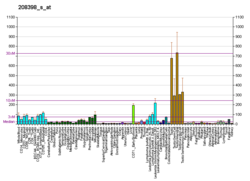TBPL1
TATA box-binding protein-like protein 1 is a protein that in humans is encoded by the TBPL1 gene.[5][6][7][8]
Function
[edit]Initiation of transcription by RNA polymerase II requires the activities of more than 70 polypeptides. The protein that coordinates these activities is transcription factor IID (TFIID), which binds to the core promoter to position the polymerase properly, serves as the scaffold for assembly of the remainder of the transcription complex, and acts as a channel for regulatory signals. TFIID is composed of the TATA-binding protein (TBP) and a group of evolutionarily conserved proteins known as TBP-associated factors or TAFs. TAFs may participate in basal transcription, serve as coactivators, function in promoter recognition or modify general transcription factors (GTFs) to facilitate complex assembly and transcription initiation. This gene encodes a protein that serves the same function as TBP and substitutes for TBP at some promoters that are not recognized by TFIID. It is essential for spermiogenesis and believed to be important in expression of developmentally regulated genes.[8]
Interactions
[edit]TBPL1 has been shown to interact with GTF2A1.[9][10]
References
[edit]- ^ a b c GRCh38: Ensembl release 89: ENSG00000028839 – Ensembl, May 2017
- ^ a b c GRCm38: Ensembl release 89: ENSMUSG00000071359 – Ensembl, May 2017
- ^ "Human PubMed Reference:". National Center for Biotechnology Information, U.S. National Library of Medicine.
- ^ "Mouse PubMed Reference:". National Center for Biotechnology Information, U.S. National Library of Medicine.
- ^ Ohbayashi T, Kishimoto T, Makino Y, Shimada M, Nakadai T, Aoki T, Kawata T, Niwa S, Tamura T (Feb 1999). "Isolation of cDNA, chromosome mapping, and expression of the human TBP-like protein". Biochemical and Biophysical Research Communications. 255 (1): 137–42. doi:10.1006/bbrc.1999.0159. PMID 10082669.
- ^ Rabenstein MD, Zhou S, Lis JT, Tjian R (Apr 1999). "TATA box-binding protein (TBP)-related factor 2 (TRF2), a third member of the TBP family". Proceedings of the National Academy of Sciences of the United States of America. 96 (9): 4791–6. Bibcode:1999PNAS...96.4791R. doi:10.1073/pnas.96.9.4791. PMC 21770. PMID 10220372.
- ^ Chong JA, Moran MM, Teichmann M, Kaczmarek JS, Roeder R, Clapham DE (Apr 2005). "TATA-binding protein (TBP)-like factor (TLF) is a functional regulator of transcription: reciprocal regulation of the neurofibromatosis type 1 and c-fos genes by TLF/TRF2 and TBP". Molecular and Cellular Biology. 25 (7): 2632–43. doi:10.1128/MCB.25.7.2632-2643.2005. PMC 1061635. PMID 15767669.
- ^ a b "Entrez Gene: TBPL1 TBP-like 1".
- ^ Ewing RM, Chu P, Elisma F, Li H, Taylor P, Climie S, McBroom-Cerajewski L, Robinson MD, O'Connor L, Li M, Taylor R, Dharsee M, Ho Y, Heilbut A, Moore L, Zhang S, Ornatsky O, Bukhman YV, Ethier M, Sheng Y, Vasilescu J, Abu-Farha M, Lambert JP, Duewel HS, Stewart II, Kuehl B, Hogue K, Colwill K, Gladwish K, Muskat B, Kinach R, Adams SL, Moran MF, Morin GB, Topaloglou T, Figeys D (2007). "Large-scale mapping of human protein-protein interactions by mass spectrometry". Molecular Systems Biology. 3 (1): 89. doi:10.1038/msb4100134. PMC 1847948. PMID 17353931.
- ^ Teichmann M, Wang Z, Martinez E, Tjernberg A, Zhang D, Vollmer F, Chait BT, Roeder RG (Nov 1999). "Human TATA-binding protein-related factor-2 (hTRF2) stably associates with hTFIIA in HeLa cells". Proceedings of the National Academy of Sciences of the United States of America. 96 (24): 13720–5. Bibcode:1999PNAS...9613720T. doi:10.1073/pnas.96.24.13720. PMC 24131. PMID 10570139.
Further reading
[edit]- Ohbayashi T, Makino Y, Tamura TA (Feb 1999). "Identification of a mouse TBP-like protein (TLP) distantly related to the drosophila TBP-related factor". Nucleic Acids Research. 27 (3): 750–5. doi:10.1093/nar/27.3.750. PMC 148243. PMID 9889269.
- Teichmann M, Wang Z, Martinez E, Tjernberg A, Zhang D, Vollmer F, Chait BT, Roeder RG (Nov 1999). "Human TATA-binding protein-related factor-2 (hTRF2) stably associates with hTFIIA in HeLa cells". Proceedings of the National Academy of Sciences of the United States of America. 96 (24): 13720–5. Bibcode:1999PNAS...9613720T. doi:10.1073/pnas.96.24.13720. PMC 24131. PMID 10570139.
- Martianov I, Brancorsini S, Gansmuller A, Parvinen M, Davidson I, Sassone-Corsi P (Feb 2002). "Distinct functions of TBP and TLF/TRF2 during spermatogenesis: requirement of TLF for heterochromatic chromocenter formation in haploid round spermatids". Development. 129 (4): 945–55. doi:10.1242/dev.129.4.945. PMID 11861477.
- Kieffer-Kwon P, Martianov I, Davidson I (Oct 2004). "Cell-specific nucleolar localization of TBP-related factor 2". Molecular Biology of the Cell. 15 (10): 4356–68. doi:10.1091/mbc.E04-02-0138. PMC 519132. PMID 15269281.
- Rual JF, Venkatesan K, Hao T, Hirozane-Kishikawa T, Dricot A, Li N, Berriz GF, Gibbons FD, Dreze M, Ayivi-Guedehoussou N, Klitgord N, Simon C, Boxem M, Milstein S, Rosenberg J, Goldberg DS, Zhang LV, Wong SL, Franklin G, Li S, Albala JS, Lim J, Fraughton C, Llamosas E, Cevik S, Bex C, Lamesch P, Sikorski RS, Vandenhaute J, Zoghbi HY, Smolyar A, Bosak S, Sequerra R, Doucette-Stamm L, Cusick ME, Hill DE, Roth FP, Vidal M (Oct 2005). "Towards a proteome-scale map of the human protein-protein interaction network". Nature. 437 (7062): 1173–8. Bibcode:2005Natur.437.1173R. doi:10.1038/nature04209. PMID 16189514. S2CID 4427026.
- Ewing RM, Chu P, Elisma F, Li H, Taylor P, Climie S, McBroom-Cerajewski L, Robinson MD, O'Connor L, Li M, Taylor R, Dharsee M, Ho Y, Heilbut A, Moore L, Zhang S, Ornatsky O, Bukhman YV, Ethier M, Sheng Y, Vasilescu J, Abu-Farha M, Lambert JP, Duewel HS, Stewart II, Kuehl B, Hogue K, Colwill K, Gladwish K, Muskat B, Kinach R, Adams SL, Moran MF, Morin GB, Topaloglou T, Figeys D (2007). "Large-scale mapping of human protein-protein interactions by mass spectrometry". Molecular Systems Biology. 3 (1): 89. doi:10.1038/msb4100134. PMC 1847948. PMID 17353931.
External links
[edit]- TBPL1+protein,+human at the U.S. National Library of Medicine Medical Subject Headings (MeSH)
This article incorporates text from the United States National Library of Medicine, which is in the public domain.





